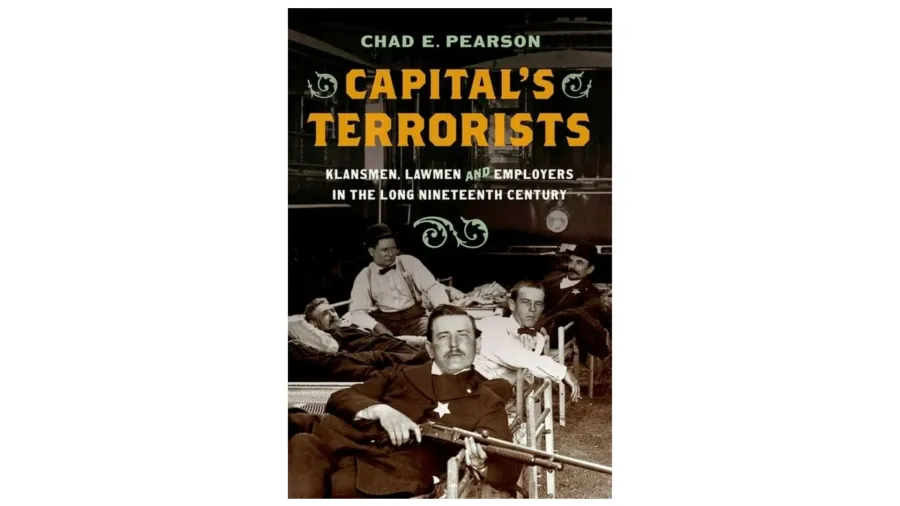Book Review: "Capital’s Terrorists: Klansmen, Lawmen, and Employers in the Long Nineteenth Century"

This book review by Michael Hillard appeared in the March edition of the University of Southern Maine Scontras Center for Labor and Community Education.
Chad Pearson’s Capital’s Terrorists: Klansmen, Lawmen, and Employers in the Long Nineteenth Century (University of North Carolina Press, 2022) is a riveting account of American employers’ violence against workers during the 19th and early 20th century. Rather than “cops and robbers,” the real gunplay story of our history is “bosses and workers.”
Ruling economic elites – including former slave owners, large cattle Western ranchers, and factory, rail, and coal owners everywhere – routinely waged warfare against workers. Their troops consisted of members of local establishments – newspapermen, lawyers, lawmen, small business owners among them – who filled out posses and vigilante organizations. Unlike European workers, US workers including immigrants struggled establishing unions because of the warfare waged against them.
Miners, cowboys, factory workers, or sharecroppers, often operating under the fascist control over their bosses (e.g. in company towns), would react to cumulative grievances – their wages being cut, horrible accidents, and/or a complete lack of freedom and civil rights. Desperate, they went on strike to win improvements and employer recognition of their representatives. Their bosses consistently responded by going to war, with the backing of local elites, courts and government officials.
While workers often fought back, and some vigilantes were killed, workers (including family and supportive community members) usually took the worst of it. Body counts of 20 or more workers killed were common, giving the US the distinction of having the bloodiest labor relations in the world. Between 500 and 800 workers died in anti-union violence between 1872 and 1914, totals that don’t include more than 100 killed in the 1919 Elaine, Arkansas massacre or the 1937 Little Steel Strike (18 strikers were shot dead). Names like Haymarket, Homestead, the Pullman Boycott, the Ludlow Massacre remind us how many innocents were killed and injured in these strikes.
Many of “capital’s terrorists” were members of either the Klu Klux Klan or “Law and Order Leagues” formed in the 1880s and 1890s. By 1903, employers nationwide formed Citizen’s Alliances, local chapters of the national Citizen’s Industrial Association of America (CIAA). Opening fire on unarmed picket lines was all–too–routine, leading, for example, to the murders of some 20 strikers in contests like Larrimore PA in 1897 and St. Louis in 1903. Vigilantes used other tools of violence and “soft power” – especially kidnapping strike leaders or strikers in their entirety and shipping them across state lines or even deporting them. Union leaders and known radicals faced the blacklist, were banned from speaking, and their books and pamphlets were burned.
Moreover, because business controlled most of the press, these massacres were routinely – and effectively – blamed on the victims. On the rare occasion these WASP vigilantes’ murderous actions brought them into court, supportive judges and ubiquitous jury nullification exempted them from accountability. If local vigilantes failed, governors assisted by sending in state militias (which happened 500 times).
Pearson highlights that capitalist terrorism was a social movement from above with notable movement leaders. He profiles men like J. West Goodwin, a Missouri newspaperman, who for nearly a half century organized Law and Order Leagues and later Citizen’s Alliances. Former Klan leader N.F. Thompson of Birmingham played a similar role, and in 1900 Congressional testimony he called for Congress to pass a “justifiable homicide law” that would legalize murdering workers during strikes.
These leaders and spokesmen propagandized that the drive to stop unions by any means necessary was somehow a matter of patriotism. Controlling the local press, they asserted their patriotism in opposing strikes and union organizing as opposition to the “lawlessness” of alleged extremists. They claimed that they were protecting “order” but also freedom– the dubious “right” of nonunion workers (scabs) to cross picket lines. The CIAA in fact even hired famous novelist Owen Wister (of the Virginian) to be its propagandist through the 1900s and 1910s.
Doublespeak and violence thus defined much of America’s boss class, an embarrassment for a nation that prides itself on the rule of law. Fortunately, the greater power of labor by the 1930s and 1940s changed norms and such violence is now rare. But the spirit of capital’s terrorism lives on in today’s union busting industry.
Michael Hillard is a recently retired Professor of Economics at the University of Southern Maine of Southern Maine. He has published widely in the fields of labor relations, labor and working–-class history, and the political economy of labor and capitalism, and taught US labor history and labor economics throughout his 36 years at USM. He is author of Shredding Paper: Labor and The Rise and Fall of Maine’s Mighty Paper Industry.
